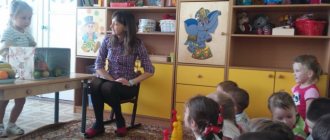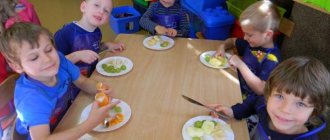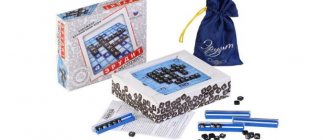Game forms are a universal means of development for preschool children. They contribute to the formation of cognitive processes and the development of the child’s personality. This article provides didactic exercises and games to develop attention in preschoolers. How we develop a child’s attention in preschool age determines how quickly the arbitrariness of this process is formed, and, consequently, the child’s preparedness for school.
Games for younger preschoolers to develop attention
Children aged 3 to 4 years old still have difficulty focusing on speech and verbal exercises. Therefore, in the development of attention it is necessary to use visual perception. It should also be taken into account that the method of cognition in younger preschoolers is visual and effective thinking. Children at this age can look at pictures, repeat actions, and compare objects. These are the games that are suitable for them to train their attention.
- Build like me! Take two sets of cubes of different colors (no more than 5). Sit next to your baby, taking one set for yourself and placing the second one in front of your child. Build a simple structure from your three or four cubes. Invite your child to build the same. If the preschooler succeeded, but without taking into account color, draw his attention to this fact. After praising your child, encourage him to do it again. As the child gets better at it, complicate the designs and add new geometric shapes (cone, cylinder...)
- What do dolls lack? Place three dolls in a row. Tell them what they are going to eat. Place a plate in front of two dolls, a spoon for two more, and also place two cups. Arrange everything so that each doll has two items. There should be utensils on the side, both necessary and unnecessary. Ask the child what is missing from the first doll, the second... Let the child complete the “setting”.
- What have you lost? Draw a simple plot picture: a house, a tree, the sun, a cloud, etc. On a separate sheet of paper, roughly repeat the basis of the drawing from the three main elements. Next, ask your child what else needs to be added, comparing both drawings.
The integrity of the concept of “attention”
Although in colloquial speech and many pieces of literature one can find a clear distribution of concentration ability by type, depending on the sensory system involved in receiving information, psychology, as a science, identifies only a holistic concept of attention, consisting of all receptor organs and systems. As well as analyzers (corresponding areas of the brain) responsible for primary and subsequent signal processing. In other words, in science there is the concept of “attention”, which is complex in itself and consists of many processes, but it is inseparable, which means that if there is a problem with any type of perception of information, visual, auditory or other, attention training is needed in general, and not just its individual type.
Without a doubt, there may be difficulties in perception associated with incomplete or impaired functionality of a certain type of receptor, but this is not at all a question of psychology and attention simulators, but a corresponding diagnosis that requires the intervention of specialists.
In other cases, lack of attention is only the inability of the analyzer (brain) to work coherently and concentratedly, rapid fatigue or absent-mindedness, which can and should be eliminated by training on attention simulators and special exercises .
Attention games for middle preschool children
A five-year-old child knows and can do much more than a younger preschooler. He has a vocabulary of 2 thousand words, understands quantitative and qualitative relationships (more - less, stronger - weaker), and perceives verbal instructions. Accordingly, the range of games and attention exercises for preschoolers is expanding.
Exercises based on visual cues
- Lunch for Matryoshkas . Prepare a set of pyramid rings and a set of sticks of different sizes. They will serve as cutlery for the nesting dolls. Set your child the task of choosing a “plate” and “spoon” for each nesting doll in accordance with its height.
- Each item has its place . Place 6 or 8 small items in two rows. Let the preschooler carefully look at what objects are and where they are. The child turns away and counts to three. During this time, the adult swaps 2-4 objects. The child will have to return everything to its place again.
- Hostess . Mix beans, peas and buckwheat in one bowl (a spoonful of each ingredient). The child will have to sort the contents. In the same way, you can mix round, square and triangular buttons, so that the preschooler can then arrange them into three piles. In addition to developing attention, this exercise helps train fine motor skills.
- Attentive buyer. Prepare several drawings consisting of only lines. But the lines are not chaotic. They are the outlines of images of vegetables and fruits. Intrigue your preschooler by the fact that he came to a grocery store that does not have display cases. The seller will only sell those fruits and vegetables that the child finds in the picture. Example drawing:
Games for auditory attention for preschoolers
- Name day. Tell your child that it is the doll’s birthday, and guests will soon come to congratulate the birthday girl. Choose 5-6 toys (these are the guests), giving each one a name. The child seats the guests around a makeshift table and treats everyone to tea, addressing everyone by name.
- Listen to the claps! Agree with the children that they will take a certain pose when they hear the claps. 1 clap – transform into a frog by squatting and touching the floor with your hands; 2 claps – transformation into a stork standing on one leg; 3 claps – free walking. Children move freely around the room and follow commands, listening to the claps.
What games should you offer for special children?
Since complete or partial hearing loss leads to other impairments, but is compensated by vision, it is important to use this fact. Children with this disorder are characterized by insufficient development of the vestibular and speech apparatus, they slowly master new movements, their speech is difficult, which affects their development as a whole.
Our task as teachers and parents is to conduct games with children that take into account the characteristics of hard of hearing or deaf children. In kindergarten I have a card index of games; it won’t hurt at home either: you will always have tools at hand for practicing with your baby.
To begin with, I would like to give general recommendations on organizing special games for children with special hearing skills:
- So, outdoor games. Children with limited hearing should clearly see how the presenter or organizer demonstrates the movements, commenting on everything out loud, clearly articulating and demonstrating the movements at a somewhat slow pace. Children, in turn, must repeat out loud the names of actions and movements. The games themselves can be varied: catch-up, knockouts, jumping ropes, ball games, etc.
- Communication games. The most important thing for preschool children is communication with peers. For children who are hard of hearing or deaf, it is very problematic, but the need is there! There are many games to develop communication skills, with role-playing games occupying a special place.
What you need to remember: through the game we must give standards for greetings, farewells, starting a conversation, requests, etc. – and all this should be spoken out and remembered by the baby. After all, he does not hear how other people and children do this, so training must be targeted. I’ve written a lot about role-playing games, but I won’t repeat myself. All types of such fun are suitable for children with hearing loss.
Exercises to develop attention in older preschoolers
Games for older preschoolers to develop attention are more complex. They require focus and concentration. In addition, they often contain a competitive condition, according to which the most inattentive are eliminated from the game. Older children are encouraged by such exercises, and they then perform them with interest without the participation of an adult.
- Look around. This game can be played anywhere. It is enough to decide what you need to see in your immediate environment. For example, on the way to kindergarten or to the store, name everything that has a round shape. Or focus on the perception of color and name yellow and green objects.
- Remember the pictures. Pre-prepared cards with the image of one object are used. Pictures of 10-12 pieces are laid out in a row, and the preschooler looks at them for 1-2 minutes. Then the cards are removed, and the child lists all the images that he remembers. The exercise also develops operational visual memory.
- Fish-bird-beast. A group game in which one person is the leader. The presenter, in the form of a counting rhyme, points to each participant and says: “fish-bird-beast-fish...”. This chain is repeated as much as the leader considers necessary. He can stop at any of these words and, pointing at the participant, become silent. This means that the participant must name a specific type of fish, bird or animal (depending on the last word). Names cannot be reused. If the answer is correct, the game continues with the same lineup. If a player gives an incorrect answer, he is eliminated from the game. Waiting for an answer is limited to counting one-two-three.
- Repeat and complete. It is better that 4-7 people take part in the game. The first participant names the word, the second repeats the word he heard and adds his own. The third one repeats the words that were spoken and completes the chain with his own word. The one who makes a mistake is out of the game.
- Listen - do it. Exercise helps develop attention and memory. The adult names a chain of actions without demonstrating them. He speaks slowly the first time, and repeats the second time at a normal pace. After this, the children reproduce the movements in the same order as listed by the presenter. Some examples of actions:
- Raise your right hand in front of you, raise your left hand up, lower both hands.
- Turn your head to the right, raise your left arm to the side, turn your head straight, raise your right arm to the side, lower your arms.
- Raise your left leg, clap your hands, lower your leg, jump.
This game is especially interesting for children if several people take part. Even the most absent-minded children try to listen and carry out all the actions.
The games presented in this article can be used for activities with one child or with a group of children. It’s great if an adult acts not only as an organizer, but also as a partner. Moreover, many exercises do not require special conditions. You can play with your child to benefit his attention during the most ordinary walk in the park.
When selecting exercises for preschoolers to develop attention, adhere to the principles of increasing complexity from simple to complex and the attractiveness of tasks. Also take into account the characteristics of the child’s temperament that affect the speed of switching attention.
Perception Games
Game “Blind Man's Bluff with a Bell”
Target
: teach children to recognize how far a sound source is from them
Age:
7-8 years
Time to play the game:
7-10 minutes
Tools:
a scarf or handkerchief made of thick fabric (you can use a mask to cover your eyes instead), a bell.
Game description:
(play in pairs in turns). The presenter announces that the game “Blind Man’s Bluff” will now begin, but not a simple one, but with a bell. Then he explains the rules. One of the participants in the game is blindfolded, and the other is given a bell. The first participant's task is to determine where the second player is by the sound of the bell and catch him. The second participant's task is to dodge the first player without being caught, but at the same time ring the bell all the time. After the first player catches the second, the participants change places. Or the loser is blindfolded, and a new participant takes the place of the player with the bell.
Of course, the first player is not allowed to peep from under the mask, and the second player is not allowed to press the bell with his finger or stop so that the bell does not ring: in these two cases, the players are disqualified.
Game “Artists”
Target:
We develop attention, coordination, perception of the shape of an object, imagination
Age:
8-10 years
Time to play the game:
7-10 minutes
Tools
: No
Game description:
First, a leader is selected who will start the game. Then all players must stand in a circle and close their eyes. The leader takes the hand of his neighbor on the left and with his right hand begins to draw a certain figure on it. This can be a well-known object (a flower, a house, a person), or simply an abstract figure (it can be drawn when the children have already mastered the game). If the second participant did not guess what kind of figure it was the first time, then it can be repeated several times. When a player has guessed this figure, he informs the presenter about this and begins to draw it on the hand of the next participant, and so on in a circle until the turn reaches the last player. He must draw it on the presenter’s hand, and he will tell you how correctly this figure reached him. If it arrived with errors, then it is necessary to analyze where the error was made and why.
Game “Who’s the odd one out here?”
Target:
development of perception of the form and qualities of an object
Age:
6-7 years
Time to play the game:
5-8 minutes
Tools
: sets consisting of identical objects and one that is somewhat different, sets of cards with images of various objects, animals, plants, etc.
Game description
: Place the first set of objects in front of the child. For example, cubes. One of these cubes must be different in some way. The difference can be very diverse, for example, in color (all the cubes will be red, and one yellow) or in shape (then a ball can be included in the set of cubes).
The child’s goal is not only to discover the extra object, but also to try to explain why he decided so.
Gradually the differences should become less noticeable. For example, you can make the following set: all the cubes are the same color, and one is older.
With each new game the number of items should increase; in parallel, you can add not just one extra item, but several. Sets of objects can be replaced with pictures.
Game
“Correct the mistakes”
Purpose:
development of visual perception
Age:
6-7 years
Time to play the game:
3-4 minutes
Tools:
a card on which alphabetic and numerical characters are correctly and mirrored, a simple pencil.
Game description:
The teacher presents the card to the child and asks the question: “Which letters and numbers are written incorrectly? Find and cross them out."
Game
“ Fold the picture ”
Purpose:
development of perception
Age:
7-8 years
Time to play the game:
2-3 minutes
Tools:
2-3 images of objects cut into pieces (for example, vegetables of different colors or different sizes, etc.).
Game description:
Option 1 - the child is presented with pictures that show parts of 2-3 images and asked to assemble whole images from these parts.
Option 2 - the child is presented with pictures, and the teacher asks to find the highlighted fragments in the whole picture and color them.
Game
“Compare by length, width, height”
Purpose:
development of visual perception
Age:
6-7 years
Time to play the game:
2-4 minutes
Tools:
images of objects of different height, width, length.
Game description:
The child is asked to show and name the longest (wide, tall) image, then the shortest (narrow, low). Place the pictures on the longest (widest, tallest, etc.) image.
Game “Draw yourself”
Target:
development of visual perception
Age:
7-8 years
Time to play the game:
10-15 minutes
Tools:
mirror, brushes, paints
Game description:
The teacher draws the children’s attention to the mirror: “Look at yourself in the mirror, touch your reflection.”
Then he distributes paints to the children and asks each child to draw himself on the mirror. The child traces the outline of his face on the mirror, draws parts of the face: eyes, eyebrows, lips, etc. Game “Walk in the Forest”
Purpose:
development of auditory perceptions
Age:
6-7 years
Time to play the game:
7-10 minutes
Tools:
audio recordings of various sounds
Game description:
children “go into the forest” and listen to the corresponding sounds. Their task is to react to these sounds in the most appropriate way: listen to the singing of birds and try to sing along with them, the rustling of leaves - caution (suddenly a snake is crawling); wind look at the sky (suddenly rain); animal cries - either hide (the bear is walking) or look (the bunny is “drumming”); the stream is murmuring - you need to look for a way around, etc. Thus, the children take a “walk in the forest”, focusing on the sounds.
Game
“ Name the Object ”
Purpose:
development of visual perception
Age:
7-8 years
Time to play the game:
5 minutes
Tools:
cards showing objects
Game description:
find and name all the objects that are depicted
Game
“ Complete the Draw ”
Purpose:
development of visual perception
Age:
6-7 years
Time to play the game:
5 minutes
Tools:
cards showing part of an object
Game description:
complete the second part of the butterfly
Didactic game for children of the preparatory group with hearing impairment
Didactic game with lids for children 6-7 years old
Summary of a lesson on a didactic game for a preparatory group of correctional educational institutions with hearing impairment.
Author: Ibatullina Lyubov Semyonovna - teacher of GBS(K)OU "NS(K)OSH No. 88 1st type", Naberezhnye Chelny RT Description : this material is recommended for teachers of preschool institutions with hearing impairment, and can also be used by teachers of general education preschool institutions. Goal : To develop children's interest in educational games. Objectives : Educational: -create a gaming environment; consolidate knowledge of colors, learn to correlate a certain color with a sign. Developmental: -develop visual and spatial perception, memory; — develop fine motor skills of the hands, coordinate speech with movement. Educational: -to develop skills of cooperation, mutual assistance, goodwill, independence. Preliminary work: Together with the children of the preparatory group, during applique classes, we made cards with a picture of a five-story city building.
Progress of the game:
I. Phonetic rhythm . (Conducted at the beginning of any lesson in a correctional educational institution for deaf children.) Su-shu, sushu, I’m writing a letter home.
Shu-su, shu-su, I see a bear in the forest. During this phonetic rhythm, work is underway to differentiate the sounds “S” and “W”.
The teacher practices clear pronunciation of the sounds “S” and “W” when repeating this quatrain many times. First, the work is carried out by the whole group, then in subgroups, sometimes in pairs. The teacher listens carefully to each child and, if necessary, works individually with the child on one or another sound (or both sounds at once). For more successful implementation of phonetic rhythms, it is necessary to accompany speech with motor exercises (movements of the arms, legs, head, body). II. Carrying out the game. Educator: Guys, today we will play. (We say this phrase behind the screen to work on the auditory perception of deaf children). At the same time, we offer children a choice of several signs of any content, but one of them should be “we will play” : “wipe the board”, “take the albums”, “we will play”. Children choose the right sign. Work with tablets is carried out with the aim of clarifying children’s understanding of the meaning of what was said. Educator: Guys, I have cards in my hands. Want to see what's there? The children take turns asking the teacher: Lyubov Semyonovna, please give me a card. (Such a dialogue between children and the teacher is an important moment for the development of speech of deaf children and it occurs regularly during classes, walks, in free activities between the children themselves, in the dining room, etc.)
Educator: Look and tell me what is depicted on them? Children : The cards show a house. Educator: That's right, this is a house. Educator: I want to read you a poem about home. Listen to it and tell me, what house is it talking about? (If the children find it difficult to answer after reading the poem, you can specify the question: Is the poem talking about a village or city house?) My house. N. Gol. Look, this is a house - With a roof, a door and a window, And with a porch and with a chimney, The color of the house is blue. Feel free to come into the house! -Are you inviting? Let's go in!
Children: This is a village house. Educator: That's right, guys, this is a village house. Why do you think that it is written about a village house? Children : The house described in the poem has a chimney. And the pipe only happens near a village house. Educator: Now listen to another poem. House. B. Serikbaev. I will draw a multi-story house. Of course, it will be a little papery. Of course, it will be a little brick, but it will be white-walled, but it will be nice. Educator: Guys, what house is this poem talking about? Children: This is a city house. Educator: That's right, about a city house.
Educator: Look at your cards and tell me what kind of house is shown there? Children: There is a city house on the card. Educator: Why, Adele, do you think this is a city house? Child: My house has 5 floors. Educator: Who has more floors in the house? Educator: Who has fewer floors in the house? Children: Everyone in the house has 5 floors. Educator: Tell me one by one, what color are your windows on the third floor? Children: Children's answers. Educator: What color are your windows located on the left? Children: They answer. Educator: What color are the windows located on the right? Children: They answer. Educator: What color are the windows in the middle? Children: Answers. Educator: Guys, I have prepared lids for you. Tell me, what color are they? Children: Multi-colored lids.
Educator: Now we will do eye exercises using these covers. Educator: Guys, take four lids and lay them out in a large square.
Educator: Look first at the top cover on the right, look at the top cover on the left, then at the bottom cover on the left, then at the bottom cover on the right. Make five such movements with your eyes. Educator: Take one lid in your hand, preferably red, extend your hand and look at the lid, and then look to the far corner of the room. Repeat five times. There are two large bright lids attached to the board, one on the right, the other on the left. Educator: Look at the right cover, then at the left. Repeat five times. Educator: Well done, guys! Your eyes are rested. Educator: Let's go back to the cards. Look at the cards and remember what color each of you has all the windows on the left. Educator : Turn over the cards, take white sheets of paper and lay out these windows using lids. Educator: Turn the cards back over. Check to see if you laid it out correctly, first at your place, and then at the neighbor on the right. Educator: Now remember what color all the windows on the right are, turn the cards over and lay them out using the lids. Educator: Check first with yourself, then with the neighbor on the left. Children with windows located in the middle perform the same task.
Using the same principle, we play with lids, laying out the windows of each floor on a white sheet of paper. Here you can distribute the children: give someone the first floor, another the second floor, etc. There is constant self-checking and mutual checking, and if necessary, children help each other. Conducting physical exercises “Home”. Educator: Let's remember what is inside the house? Children: Floor, ceiling, walls. Educator: Well done, you remembered! Teacher: gender - children squat; ceiling - children reach up with their hands; walls - children spread their arms to the sides. Runs several times. Educator : Well done! At the next stage of the game, you can take plates with the names of colors and teach them to correlate a certain color with its name.
With the youngest preschoolers, you can use the “Home” teaching card to teach them how to correlate colors. Educator: Guys, take the red lid (if the children find it difficult, take the red lid yourself). Educator : Put it on the window, also red. Educator: Well done! (If you did it correctly.) If you do not correlate the red lid with the red color of the window, take the hand of the child holding the red lid and, emphasizing the voice with a questioning intonation, ask him: Educator: Correct? And give the child time to think. If the child still cannot complete this task, the teacher makes a smooth movement with his other hand towards the red window to attract the child’s attention. And then be sure to praise him. Work this way with all primary colors. It was a slight retreat. III . Summary of the lesson. Educator: Guys, what did we do today? (First, the children speak together, and then I ask each child separately - for speech development.) Educator: Did you like playing with the lids? Educator: You are all great, you all played well, thought and spoke well.
We recommend watching:
Didactic game for children 5-7 years old. Valeological lotto Plot-based didactic game for children 5-7 years old Didactic game for preschoolers and primary schoolchildren “Trees and shrubs of our city.” Didactic game for children of the preparatory group of kindergarten
Similar articles:
Logical game for children of the preparatory group of kindergarten
Summary of a musical didactic game for children of the preparatory group “Who is the composer”





